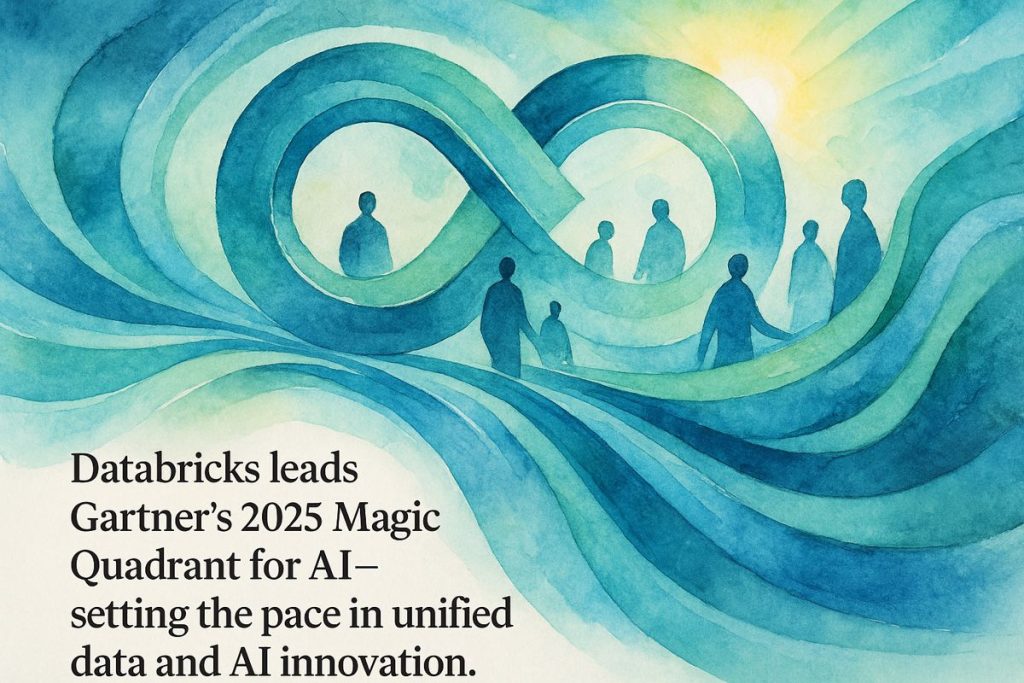Databricks was named a Leader in the 2025 Gartner Magic Quadrant for Data Science and Machine Learning because of its powerful lakehouse technology, which blends all types of data in one smooth platform. This makes it easy for companies to work with big data, build AI models, and keep everything secure and organized. Databricks stands out with smart tools for generative AI, thanks to MosaicML, and strong support for the whole AI process. Customers from all kinds of industries trust Databricks because it helps them handle tough data problems, meet strict rules, and move fast with new technology.
Why was Databricks named a Leader in the 2025 Gartner Magic Quadrant for Data Science and Machine Learning Platforms?
Databricks was named a Leader in the 2025 Gartner Magic Quadrant for Data Science and Machine Learning Platforms due to its innovative lakehouse architecture, strong AI lifecycle support, advanced generative AI capabilities (via MosaicML), robust compliance features, and proven ability to execute and deliver visionary solutions for diverse industries.
The Magic Quadrant and a Dash of Serotonin
Let’s get the dopamine hit out of the way first: Databricks has yet again landed in the “Leader” quadrant of the 2025 Gartner Magic Quadrant for Data Science and Machine Learning Platforms. That’s four years running, if you’re counting—and honestly, who isn’t? There’s something undeniably satisfying about seeing your name perched at the top right, right next to “Ability to Execute” and “Completeness of Vision.” It’s like winning the science fair and then having your project displayed in the school trophy case for a year—except in this case, the school is basically every Fortune 500 company, and the judges are notoriously hard to impress.
But let’s pause. What is it that makes Gartner’s Magic Quadrant the North Star for so many CIOs? Simple: it’s a hyperspectral analysis of the vendor landscape, where “Leaders” aren’t just competent—they’re visionaries with the receipts to prove it. Databricks didn’t just squeeze into that rarefied space; it edged out juggernauts like Microsoft Azure and Amazon Web Services on both axes, according to Virtualization Review. Aha! That little spike of pride? Yes, I felt it. And I had to stop and ask myself: is there a catch? Was this just a well-played marketing gambit? Spoiler—no, there’s genuine substance here.
I remember the first time I tried to explain the Magic Quadrant’s axes to a non-tech friend. “So, it’s like a map for robots?” Close enough. Sometimes, metaphors are our only raft in a sea of jargon.
Lakehouse: Where Data Sleeps and Dreams
The secret sauce—or perhaps the aromatic blend of coffee beans—in Databricks’ arsenal is its lakehouse architecture. Picture a palimpsest, layers of structured and unstructured data written, erased, and rewritten, but all available from a single platform. The lakehouse isn’t just a catchy name. It’s an elegant hybrid, merging the flexibility of data lakes with the rigorous order of warehouses. This means analytics and machine learning can both sip from the same cup—no more schlepping your data across silos like a medieval scribe hauling scrolls between monasteries.
There’s something tactile about the way Databricks’ lakehouse reduces friction. You can almost hear the satisfying click as disparate datasets lock into place, ready for use. I once built a project for a pharma client who was drowning in CSV files, SharePoint folders, and “mystery” Excel sheets. With Databricks, we corralled the chaos into a single, queryable pool. Relief? Palpable. And the faint, reassuring hum of the data pipeline became my new favourite soundtrack at 2am.
Of course, there’s more under the hood. Databricks’ support spans the entire AI lifecycle: ingestion, cleaning, experimentation, model deployment—the works. Its compliance features aren’t just a nice-to-have; they’re must-haves for industries like pharmaceuticals and financial services. (If you’re in either, you know the existential dread of an audit.)
From MosaicML to Managed MLflow: A Quiver of AI Tools
You want specifics? Let’s talk about how Databricks acquired MosaicML and turbocharged its generative AI capabilities. Suddenly, customers could fine-tune large language models (LLMs), wield AI Gateway and Vector Search, and orchestrate model serving pipelines with Managed MLflow. That’s not marketing fluff; it’s the kind of infrastructural uplift you feel in your bones, especially when your CEO is hounding you for “Enterprise-Ready Generative AI” by Q2.
In the 2025 Magic Quadrant report, Gartner specifically calls out Databricks’ prowess in supporting agent development and LLM fine-tuning. That’s a nod to Mosaic, yes, but also to the ecosystem Databricks has cultivated—one where new tools slot in with minimal friction. I admit, I underestimated how quickly teams would jump from classic machine learning to full-on generative AI workflows. Turns out, give them the right scaffolding and they’ll scale a cathedral overnight.
But here’s the kicker: Databricks’ open-source ethos isn’t window-dressing. With roots in Apache Spark, Delta Lake, and MLflow, Databricks has spent the last decade as both steward and innovator. The annual Data+AI Summit is more than a conference. It’s a living, breathing marketplace of ideas; I once wandered into a session on Delta Lake time travel and left with enough notebook snippets to fill a novella. The smell of sharpies, coffee, and ambition? Unmistakable.
The Real World: Use Cases and Unvarnished Opinions
It’s one thing to rack up accolades, but it’s another to earn the trust of sectors where uptime and compliance are non-negotiable. Take life sciences: researchers use Databricks to wrangle genomic data, run simulations, and optimize clinical trials
